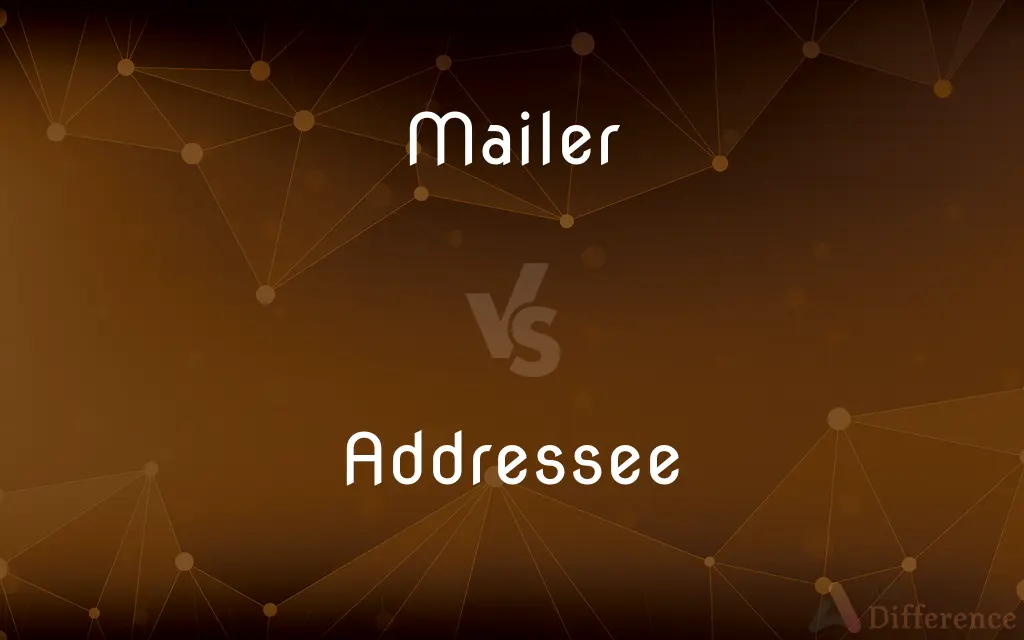Mailer vs. Addressee — What's the Difference?
By Urooj Arif & Maham Liaqat — Updated on March 7, 2024
A mailer is the person or entity that sends mail, while the addressee is the recipient of the mail.

Difference Between Mailer and Addressee
Table of Contents
ADVERTISEMENT
Key Differences
The mailer, often an individual or organization, initiates the mailing process by preparing and sending out mail to another party. This role involves choosing the content, packaging, and postage, ensuring the mail reaches its intended destination. On the other hand, the addressee is the person or entity designated to receive the mail. The addressee's role is passive in the mailing process, as they await the arrival of the mail and are responsible for opening and responding to it, if necessary.
While the mailer must ensure that the mail is correctly addressed, packaged, and posted, the addressee must provide a valid and accessible address. If the addressee’s address is incomplete or incorrect, it may result in mail delivery failure. Conversely, the mailer’s responsibility is to accurately address and sufficiently postage the mail to facilitate its successful delivery.
In terms of communication, the mailer conveys information, requests, or goods, which signifies an active attempt to communicate or transfer items. The addressee, whereas, is the targeted end of this communication, whose reaction or response can vary from acknowledgment to taking specific actions based on the mail's contents.
The relationship between a mailer and addressee is defined by the flow of mail from one to the other, establishing a sender-receiver dynamic crucial for various purposes, including personal communication, business transactions, and legal notices. This dynamic underscores the importance of clear and accurate information from both parties to ensure effective communication.
The interaction between mailer and addressee can be influenced by the type of mail sent. For instance, promotional materials might not elicit a direct response from the addressee, while personal letters or official documents might require action or reply, showcasing the diverse nature of mail-based communication.
ADVERTISEMENT
Comparison Chart
Role in Mailing Process
Initiates the sending of mail.
Receives the mail.
Responsibilities
Correct addressing, packaging, and postage.
Providing a valid, accessible address.
Communication Role
Active sender conveying information or goods.
Passive recipient, may respond or act upon receiving.
Impact on Mail Delivery
Responsible for mail reaching its destination.
Must ensure address is correct to receive mail.
Response to Mail
May await confirmation or response.
Opens, reads, and possibly responds to the mail.
Compare with Definitions
Mailer
The originator of a mailed package or letter.
As the mailer, she ensured the parcel was securely wrapped.
Addressee
The person or place to whom mail is sent.
The addressee was not home to receive the registered mail.
Mailer
The sender side in a mail transaction.
The mailer included a return address in case of delivery issues.
Addressee
The recipient of a letter or package.
The package’s addressee had to sign for its delivery.
Mailer
An individual or entity that sends mail.
The company became a frequent mailer of promotional offers.
Addressee
The target of a sender's mailed communication.
The addressee responded to the letter with gratitude.
Mailer
A term for pre-paid postage envelopes or packages.
He used a bubble mailer to protect the contents.
Addressee
A term used to identify the receiving party in a shipment.
The addressee's details were clearly printed on the front.
Mailer
Someone who uses mailing services for communication.
As a political campaign mailer, they sent thousands of flyers.
Addressee
Someone who receives mail or parcels.
As the addressee, he was curious about the unexpected package.
Mailer
One that uses the mails
Large commercial mailers.
Addressee
The one to whom something is addressed.
Mailer
One who addresses, stamps, or otherwise prepares mail.
Addressee
The person or organization to which something, such as a letter or message, is addressed or sent, for whom the item is intended.
Mailer
A container, such as a cardboard tube, used to hold material to be mailed
A cardboard book mailer.
Addressee
(linguistics) A person or entity to whom discourse is directed, or the words referring to such an entity.
Mailer
An advertising leaflet included with a letter.
Addressee
One to whom anything is addressed.
Mailer
One who sends mail.
Addressee
One to whom something is addressed
Mailer
A computer program that sends electronic mail.
Mailer
A packet or container designed for postal use.
The cassette came in a brown paper mailer.
Mailer
A mailshot; advertising sent by mail.
Mailer
United States writer (born in 1923)
Mailer
A person who mails something
Mailer
An advertisement that is sent by mail
Mailer
A container for something to be mailed
Common Curiosities
What happens if a mailer incorrectly addresses a package?
Incorrect addressing by the mailer can lead to delivery delays, returns to the sender, or misdelivery.
Is the mailer responsible for the postage costs?
Typically, the mailer covers postage costs, though in some cases, postage may be due upon receipt by the addressee.
What role does packaging play for the mailer?
Proper packaging protects the contents and ensures the mail reaches the addressee in good condition.
Can the addressee refuse to accept mail?
Yes, the addressee has the right to refuse mail, especially if it is unsolicited or requires acceptance upon delivery.
What is a bulk mailer?
A bulk mailer is an entity that sends large volumes of mail, usually at a discounted postage rate, often for promotional purposes.
Do mailers need to identify themselves?
For certain types of mail, especially legal or commercial, the mailer is required to identify themselves.
Can anyone be a mailer?
Yes, any individual or entity can send mail, provided they adhere to the postal regulations and pay the necessary postage.
What happens when mail is wrongly delivered?
Wrongly delivered mail should be returned to the postal service for correct delivery or redirection to the intended addressee.
How can an addressee ensure they receive their mail?
The addressee should provide a complete, accurate address and may need to meet specific delivery requirements (e.g., signature).
What if the addressee's address is no longer valid?
Mail may be returned to the sender or handled according to the postal service's procedures for undeliverable mail.
How does the mailer choose the right postage?
The mailer selects postage based on weight, size, destination, and desired delivery speed of the mail.
Can an addressee be a business or organization?
Yes, businesses and organizations can also be addressees, receiving mail addressed to their official name or department.
Can an addressee track their mail?
If the mailer provides tracking information, the addressee can track the package or letter through the carrier’s system.
Is it important for the addressee to check their mail regularly?
Regular mail checks ensure timely receipt of important documents and reduce the risk of theft or misplacement.
What are the responsibilities of the addressee upon receiving mail?
Responsibilities include securing the mail, opening it, and acting accordingly, whether by responding or fulfilling a request.
Share Your Discovery

Previous Comparison
Manner vs. Demeanor
Next Comparison
Incomplete vs. UncompletedAuthor Spotlight
Written by
Urooj ArifUrooj is a skilled content writer at Ask Difference, known for her exceptional ability to simplify complex topics into engaging and informative content. With a passion for research and a flair for clear, concise writing, she consistently delivers articles that resonate with our diverse audience.
Co-written by
Maham Liaqat












































